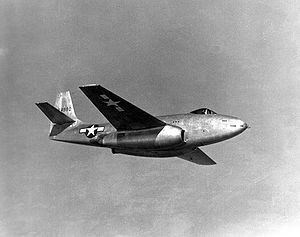Top speed 840 km/h Length 14 m Engine type Allison J33 | Wingspan 16 m First flight February 25, 1945 | |
 | ||
The Bell XP-83 (later redesignated ZXF-83) was a United States prototype escort fighter designed by Bell Aircraft during World War II. It first flew in 1945. As an early jet fighter, its limitations included a lack of power and it was soon eclipsed by more advanced designs.
Contents
Design and development
The early jet fighters consumed fuel at a prodigious rate, which severely limited their range and endurance. In March 1944, the United States Army Air Forces requested Bell to design a fighter with increased endurance, and formally awarded a contract for two prototypes on 31 July 1944.
Bell had been working on its "Model 40" interceptor design since 1943. It was redesigned as a long-range escort fighter, retaining the general layout of the P-59 Airacomet. The two General Electric J33-GE-5 turbojet engines were located in each wing root, which left the large and bulky fuselage free for fuel tanks and armament. The fuselage was an all-metal semimonocoque, capable of carrying 1,150 gal (4,350 l) of fuel; in addition, two 250 gal (950 l) drop tanks could be carried. The cabin was pressurized, and the canopy a small and low bubble type. The armament was to be six 0.5 in (12.7 mm) machine guns in the nose.
Testing
Early wind tunnel reports had pinpointed directional instability but the "fix" of a larger tail would not be ready in time for flight testing. The first prototype was flown on 25 February 1945, by Bell's chief test pilot Jack Woolams, who found it to be underpowered and unstable. The limited flight testing provided satisfactory flight characteristics although spins were restricted until the larger tailfin was installed. The second prototype did incorporate the extended tail and an aileron boost system. One unique characteristic was the XP-83's refusal to "slow down" due to its sleek aerodynamic shape and lack of drag brakes; test pilots were forced to fly very long and flat landing approaches.
The first prototype was used in 1946 as a ramjet testbed, with an engineer's station located in the fuselage behind the pilot and on 14 September 1946 one of the ramjets caught fire - the pilot "Slick" Goodlin and engineer Charles Fay had to parachute out. The second prototype flew on 19 October and was scrapped in 1947. Apart from range, the XP-83 was inferior to Lockheed's P-80 Shooting Star, and the XP-83 project was canceled in 1947.
Specifications (XP-83)
Data from War Planes of the Second World War
General characteristics
Performance
Armament
